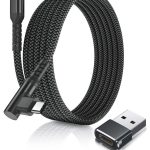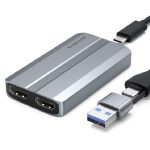In today’s world of ever-evolving technology, connecting devices seamlessly is a necessity. USB-C has emerged as a versatile port, promising a unified solution for data transfer, charging, and even video output. But does USB-C to HDMI truly work? Let’s delve deeper into this topic and explore the possibilities, limitations, and potential pitfalls.
Contents
- 1 The Promise of USB-C
- 2 When it Works: Seamless Connectivity
- 3 When it Doesn’t: The Limitations
- 4 Choosing the Right Adapter or Cable
- 5 Troubleshooting Tips
- 6 Beyond HDMI: Other Possibilities
- 7 The Future of USB-C and Video Output
- 8 Unveiling the Technology: How USB-C to HDMI Works
- 9 The Future of USB-C and Video Output
- 10 Conclusion
The Promise of USB-C
USB-C, with its compact and reversible design, has gained popularity for its multi-functionality. Besides power delivery and data transfer, it also supports alternate modes, enabling it to carry video signals like DisplayPort and HDMI. This seemingly eliminates the need for multiple cables and adapters, simplifying our tech lives.
The key to understanding USB-C to HDMI lies in “alternate modes.” These are special protocols that allow USB-C to carry signals other than its native USB data. DisplayPort Alternate Mode is the most common way USB-C handles video output, and it can seamlessly convert to HDMI using a simple adapter or cable.
When it Works: Seamless Connectivity
Laptops and Desktops
Most modern laptops and some desktops with USB-C ports support DisplayPort Alternate Mode, making them readily compatible with HDMI displays. A USB-C to HDMI cable or adapter is often all you need to mirror or extend your screen to a TV or monitor.
Smartphones and Tablets
Many Android devices and even some iPads now have USB-C ports with DisplayPort Alternate Mode support. This opens up possibilities for connecting to larger screens for presentations, gaming, or streaming content.
Other Devices
Devices like gaming consoles, cameras, and even some docking stations may offer USB-C with video output capabilities, expanding the potential for connecting to HDMI displays.
When it Doesn’t: The Limitations
- Not All USB-C Ports are Equal: While USB-C ports may look identical, not all of them support video output. It’s essential to check your device’s specifications or look for a DisplayPort or Thunderbolt logo next to the port.
- Legacy Devices: Older devices with USB-C may lack alternate mode support, limiting their ability to output video via HDMI.
- Compatibility Issues: In rare cases, even with compatible devices, you might encounter compatibility issues with specific adapters or cables. It’s always wise to opt for certified products or those from reputable brands.
Choosing the Right Adapter or Cable
- Active vs. Passive: Active adapters have built-in electronics to handle signal conversion, often offering better compatibility and support for higher resolutions. Passive adapters are simpler and more affordable but may have limitations.
- Resolution and Refresh Rate: Consider the resolution and refresh rate you need. Some adapters or cables may only support up to 1080p, while others can handle 4K or even higher resolutions at various refresh rates.
- Additional Features: Some adapters or cables may offer additional features like audio support or multiple output ports. Consider your specific requirements before making a purchase.

Troubleshooting Tips
- Check Port Compatibility: Double-check if your USB-C port supports video output.
- Update Drivers and Firmware: Ensure your device’s drivers and firmware are up to date.
- Try a Different Adapter or Cable: If you’re facing issues, try a different adapter or cable.
- Restart Devices: Sometimes, a simple restart can resolve connectivity problems.
- Consult Manufacturer Support: If all else fails, contact the manufacturer of your device or adapter for assistance.
Beyond HDMI: Other Possibilities
While USB-C to HDMI is a popular option, it’s not the only way to connect your devices.
- USB-C to DisplayPort: If your display has a DisplayPort input, a direct USB-C to DisplayPort cable can be a reliable and high-performance option.
- Docking Stations: USB-C docking stations often offer multiple video output options, including HDMI, DisplayPort, and even VGA, providing flexibility for connecting various displays.
- Wireless Solutions: Wireless display technologies like Miracast or Chromecast can offer a cable-free alternative for streaming content from your device to a TV or monitor.
The Future of USB-C and Video Output
As technology continues to advance, we can expect even broader adoption of USB-C with video output capabilities. This will further simplify connectivity and streamline our workflows. Additionally, the emergence of new standards like USB4 promises even higher bandwidth and greater flexibility for video transmission over USB-C.
So, does USB-C to HDMI work? The answer is a resounding yes, in most cases. With the right hardware and accessories, you can seamlessly connect your USB-C devices to HDMI displays, unlocking a world of possibilities for productivity, entertainment, and more. Just remember to check for compatibility, choose the right adapter or cable, and troubleshoot any issues that may arise.
Embrace the versatility of USB-C, and experience the convenience of connecting your devices effortlessly. Whether it’s for work, play, or creative pursuits, USB-C to HDMI opens doors to a world of seamless visual experiences.

Unveiling the Technology: How USB-C to HDMI Works
The Role of DisplayPort
- DisplayPort Alternate Mode: As mentioned earlier, DisplayPort Alternate Mode is the bridge between USB-C and HDMI. It allows USB-C ports to transmit DisplayPort signals, which can then be easily converted to HDMI using an adapter or cable.
- Advantages of DisplayPort: DisplayPort is a powerful video interface known for its high bandwidth and support for high resolutions and refresh rates. This makes it ideal for handling the demands of modern displays, including 4K and even 8K resolutions.
Active vs. Passive Adapters: Understanding the Difference
- Active Adapters: These adapters contain a small chip that actively converts DisplayPort signals to HDMI signals. They are typically more expensive but offer better compatibility, support for higher resolutions and refresh rates, and often include additional features like audio support.
- Passive Adapters: These adapters are simpler and more affordable, relying on the device’s built-in capabilities to handle signal conversion. They may have limitations in terms of supported resolutions and refresh rates and might not be compatible with all devices.
Choosing the Right Adapter: Factors to Consider
- Compatibility: Ensure the adapter is compatible with your specific device and the desired HDMI display. Check the manufacturer’s specifications and reviews for compatibility information.
- Resolution and Refresh Rate: Choose an adapter that supports the resolution and refresh rate you need for your display.
- Build Quality and Durability: Opt for adapters from reputable brands with a solid build quality to ensure longevity and reliable performance.
- Additional Features: Consider if you need additional features like audio support or multiple output ports.
Setting up Your USB-C to HDMI Connection
- Connect the USB-C end of the adapter or cable to your device’s USB-C port.
- Connect the HDMI end of the adapter or cable to your HDMI display.
- If using an active adapter, it may require additional power from a USB port or power adapter.
- Your device should automatically detect the HDMI display and adjust the output accordingly.
- If not, you may need to manually adjust the display settings in your device’s operating system.
The Future of USB-C and Video Output
- USB4: The upcoming USB4 standard promises even greater bandwidth and flexibility for video transmission over USB-C, potentially enabling even higher resolutions and refresh rates.
- Thunderbolt 4: Thunderbolt 4, which is based on USB4, also offers high-performance video output capabilities over USB-C, further solidifying USB-C’s position as a versatile interface for connecting displays.
- Continued Innovation: As technology evolves, we can expect further advancements in USB-C video output, with new features and capabilities emerging to enhance our connectivity experience.

Conclusion
USB-C to HDMI is a powerful and convenient solution for connecting your devices to displays. By understanding the underlying technology, choosing the right adapter, and following the setup steps, you can enjoy seamless video output and unlock the full potential of your USB-C devices.
Embrace the future of connectivity with USB-C to HDMI. Whether you’re presenting, gaming, streaming, or simply enjoying your favorite content on a bigger screen, this versatile technology empowers you to connect and create with ease.


